
Two-Week Adventure in Paris, Brussels, and Amsterdam
 14 Day Tour of Paris, Brussels and Amsterdam
14 Day Tour of Paris, Brussels and Amsterdam
Overview
Trip Map
Itinerary
Inclusions
Reviews







14 Days 13 Nights
Best Time: Jan-Dec
Visiting Museums & Art Galleries
Local Cuisine & Wine
Experience the best of France, Belgium, and the Netherlands on this immersive journey including Paris, Brussels, and Amsterdam. Begin in Paris, where you'll ascend the iconic Eiffel Tower, peruse art treasures in the Louvre, and wander the charming streets of Montmartre. In Belgium, indulge in the culinary delights of Brussels and savor the historic beauty of Bruges on an excursion. Finally, uncover Amsterdam's picturesque canals, renowned museums, and vibrant neighborhoods, while also venturing into the Dutch countryside. With detailed travel guidance provided by our mobile app, the trip is guaranteed to be as stress-free as it is rewarding.
- Explore the opulent Palace of Versailles and its breathtaking gardens on a self-guided excursion.
- Stroll through the Grand Place in Brussels and enjoy a chocolate-making tour.
- Take an excursion to Bruges to see its enchanting canals and to discover its medieval charm.
- Visit the Anne Frank House and explore Amsterdam's Jewish Quarter.
- Marvel at the windmills of Zaanse Schans on a scenic day trip.
Experience the best of France, Belgium, and the Netherlands on this immersive journey including Paris, Brussels, and Amsterdam. Begin in Paris, where you'll ascend the iconic Eiffel Tower, peruse art treasures in the Louvre, and wander the charming streets of Montmartre. In Belgium, indulge in the culinary delights of Brussels and savor the historic beauty of Bruges on an excursion. Finally, uncover Amsterdam's picturesque canals, renowned museums, and vibrant neighborhoods, while also venturing into the Dutch countryside. With detailed travel guidance provided by our mobile app, the trip is guaranteed to be as stress-free as it is rewarding.
- Explore the opulent Palace of Versailles and its breathtaking gardens on a self-guided excursion.
- Stroll through the Grand Place in Brussels and enjoy a chocolate-making tour.
- Take an excursion to Bruges to see its enchanting canals and to discover its medieval charm.
- Visit the Anne Frank House and explore Amsterdam's Jewish Quarter.
- Marvel at the windmills of Zaanse Schans on a scenic day trip.

Eiffel Tower
Historic Landmarks

Louvre Museum
Museums & Galleries

Arc de Triomphe
Architecture

Grand Place
Historic Landmarks

Atomium
European History

Manneken Pis
Historic Landmarks

Old Town
Historic Landmarks

Museum Quarter
Museums & Galleries

Anne Frank House
Historic Landmarks
Must see sights

Eiffel Tower
Historic Landmarks

Louvre Museum
Museums & Galleries

Arc de Triomphe
Architecture

Grand Place
Historic Landmarks

Atomium
European History

Manneken Pis
Historic Landmarks

Old Town
Historic Landmarks

Museum Quarter
Museums & Galleries

Anne Frank House
Historic Landmarks
Starting from
$3895
per person
 Not included
Not included Secure Your Customizable Trip
Enter your details to embark on a journey that can be tailored just for you.
Start
Travelers
0 travelers
Add Room
Remove Room
Preferred Hotel Stars
Select Hotel Stars
Craft Your Own Itinerary
Select your interests and destinations for a trip plan inspired by you.
Trip Map & Itinerary
Enable/Disable Map Scrolling
Click To Make Map Interactive

Trip Timeline
 Edit Details
Edit DetailsArrival
5 nights
Paris
France
Train: 2.5h
3 nights
Brussels
Belgium
Train: 3h
5 nights
Amsterdam
Netherlands
Departure
Day-By-Day Itinerary

Day 1
Arrive Paris
Day 1
Arrive Paris



To Be Determined
Arrival in Paris Airport & Transfer by Taxi
Upon arrival at one of Paris's Charles de Gaulle or Orly Airports, it's fairly easy to catch a taxi from outside the main terminal building to your hotel. This is cheaper than a pre-arranged private transfer, although that option is also available if you wish - just ask your consultant. Parisien taxi drivers are generally reliable and honest, but we will provide you with instructions on how to avoid possible scammers and charlatans. If you want to save money, and often quite a lot of time as well, we will also give you alternative instructions on taking public transport into the city center. Details are contained in the full itinerary and mobile app available to our travelers. If on the other hand, you are arriving at Paris's third airport, Beauvais Airport (BVA), then you should always take the shuttle bus. The taxi fare might cost more than the flight - it's nearly 50 miles (75km) outside the city.

Day 1
Arrive Paris


Day 1
Arrive Paris




To Be Determined:
Airport Taxi Pick-Up
Mid-Day/Afternoon:
Tuileries Gardens & Nearby Museums
Late Afternoon/Early Evening:
Hôtel des Invalides


Day 2
Paris
Day 2
Paris



9:00 AM - 1:00 PM
Private Guided Walking Tour of the Center of Paris
Embark on a captivating 4-hour walking tour of the center of Paris, the City of Lights, where history and modernity blend seamlessly along its enchanting streets. Starting from your accommodation, you will explore the heart of this dynamic city and learn how to navigate Paris as a local.

Day 2
Paris



Day 3
Paris
Day 3
Paris


Morning to Afternoon
The Eiffel Tower From Above and Below
Maybe the most recognized landmark in the world, the Eiffel Tower never fails to impress and inspire. Its elegance has always drawn crowds, and it demands a little logistical planning in order to expedite the security checks and avoid the crowds. We'll provide you with very detailed information on how to do this in the Full Itinerary, along with how to purchase tickets to speed up your visit. Let your consultant know if you wish to have your Eiffel Tower tickets purchased for you - they require a very specific time slot. We will also provide you with information on the other grand sights to visit nearby, including the famous Museum of Man across the river at Trocadero, and the Quai Branly Museum.

Museum of Man
Ponder some of the Big Questions while visiting this museum...
Show More

Palais de Tokyo
Discovering the greatest of modern and contemporary French art in this dramatic structure
Show More

Quai Branly Museum
Discover a captivating collection of indigenous art in this literally verdant building.
Show More

Museum of Man
Ponder some of the Big Questions while visiting this museum...
Show More

Palais de Tokyo
Discovering the greatest of modern and contemporary French art in this dramatic structure
Show More

Quai Branly Museum
Discover a captivating collection of indigenous art in this literally verdant building.
Show More

Museum of Man
Ponder some of the Big Questions while visiting this museum...
Show More
prev
next

Day 3
Paris

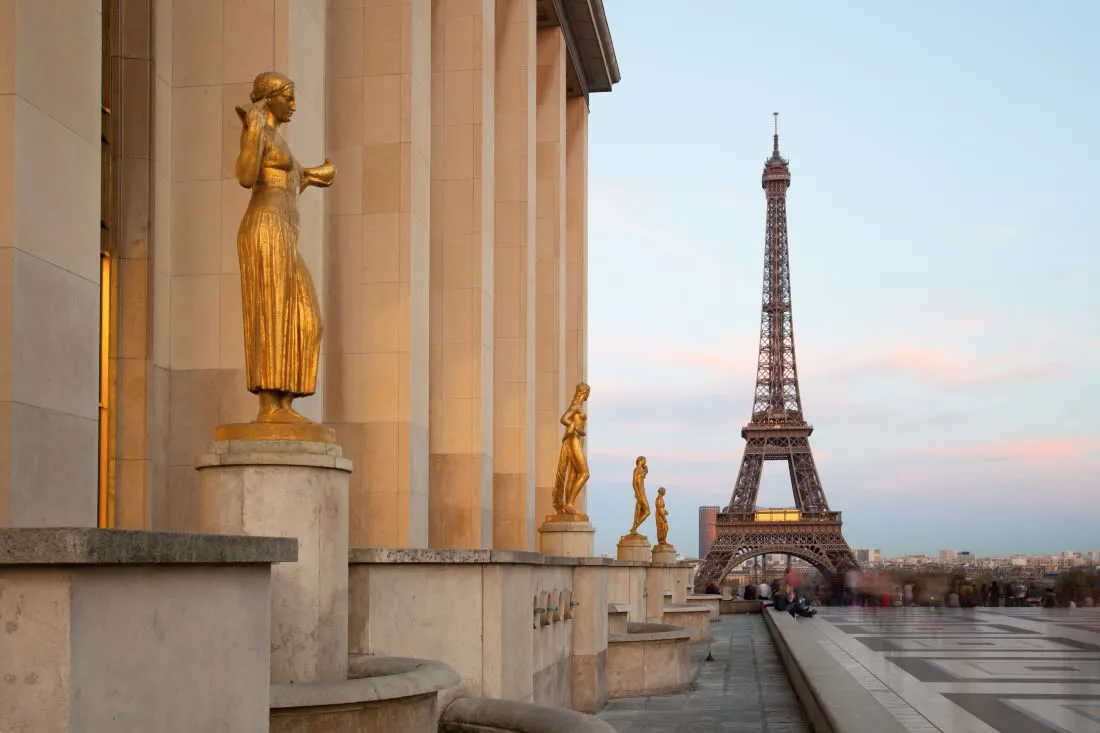
Museum of Man
 Highlight of Eiffel Tower
Highlight of Eiffel TowerPonder some of the Big Questions while visiting this museum...
Le Musée de l'Homme in Paris's Place du Trocadéro delves into human evolution and diversity through anthropology, ethnology, and prehistory. Showcasing artifacts from prehistoric tools to modern art, it highlights humans' biological and cultural development while exploring our identities, societies, and relationship with nature. Interactive and engaging, the museum offers a profound investigation into the essence of humanity, prompting reflection on our collective past and future.

Palais de Tokyo
 Highlight of Eiffel Tower
Highlight of Eiffel TowerDiscovering the greatest of modern and contemporary French art in this dramatic structure
Que vous seriez un peu plus parisien(ne)... That you would be a bit more Parisian, visit the Palais de Tokyo in the 16th arrondissement, a beacon of contemporary art known for its avant-garde exhibitions and innovative art installations. Blending historical elegance with modern creativity, it offers visitors a privilaged exploration of the latest artistic expressions. Highlights include its own modernist architecture, a constantly evolving array of exhibitions showcasing everything from installations to live performances, and the Yoyo nightclub and Le Tokyo Eat for leisure and dining. Visit the Palais de Tokyo to step into an intersection of art, culture, and architecture, and let the cutting edge of contemporary art in Paris take you away.

Quai Branly Museum
 Highlight of Eiffel Tower
Highlight of Eiffel TowerDiscover a captivating collection of indigenous art in this literally verdant building.
The Quai Branly Museum, oficially known as L'Musée du quai Branly - Jacques Chirac, is a vibrant celebration of indigenous art and cultures from Africa, Asia, Oceania, and the Americas. Located on the banks of the Seine near the Eiffel Tower, this innovative museum stands out with its striking modern architecture and a lush wall garden adorning its exterior. Inside, visitors are treated to a rich tapestry of artifacts, including traditional costumes, masks, sculptures, and jewelry, all showcased in a dynamic and immersive display. The museum's commitment to cultural diversity and its extensive collection offer a unique opportunity to explore the history, art, and traditions of non-Western civilizations.

Museum of Man
 Highlight of Eiffel Tower
Highlight of Eiffel TowerPonder some of the Big Questions while visiting this museum...
Le Musée de l'Homme in Paris's Place du Trocadéro delves into human evolution and diversity through anthropology, ethnology, and prehistory. Showcasing artifacts from prehistoric tools to modern art, it highlights humans' biological and cultural development while exploring our identities, societies, and relationship with nature. Interactive and engaging, the museum offers a profound investigation into the essence of humanity, prompting reflection on our collective past and future.

Palais de Tokyo
 Highlight of Eiffel Tower
Highlight of Eiffel TowerDiscovering the greatest of modern and contemporary French art in this dramatic structure
Que vous seriez un peu plus parisien(ne)... That you would be a bit more Parisian, visit the Palais de Tokyo in the 16th arrondissement, a beacon of contemporary art known for its avant-garde exhibitions and innovative art installations. Blending historical elegance with modern creativity, it offers visitors a privilaged exploration of the latest artistic expressions. Highlights include its own modernist architecture, a constantly evolving array of exhibitions showcasing everything from installations to live performances, and the Yoyo nightclub and Le Tokyo Eat for leisure and dining. Visit the Palais de Tokyo to step into an intersection of art, culture, and architecture, and let the cutting edge of contemporary art in Paris take you away.

Quai Branly Museum
 Highlight of Eiffel Tower
Highlight of Eiffel TowerDiscover a captivating collection of indigenous art in this literally verdant building.
The Quai Branly Museum, oficially known as L'Musée du quai Branly - Jacques Chirac, is a vibrant celebration of indigenous art and cultures from Africa, Asia, Oceania, and the Americas. Located on the banks of the Seine near the Eiffel Tower, this innovative museum stands out with its striking modern architecture and a lush wall garden adorning its exterior. Inside, visitors are treated to a rich tapestry of artifacts, including traditional costumes, masks, sculptures, and jewelry, all showcased in a dynamic and immersive display. The museum's commitment to cultural diversity and its extensive collection offer a unique opportunity to explore the history, art, and traditions of non-Western civilizations.

Museum of Man
 Highlight of Eiffel Tower
Highlight of Eiffel TowerPonder some of the Big Questions while visiting this museum...
Le Musée de l'Homme in Paris's Place du Trocadéro delves into human evolution and diversity through anthropology, ethnology, and prehistory. Showcasing artifacts from prehistoric tools to modern art, it highlights humans' biological and cultural development while exploring our identities, societies, and relationship with nature. Interactive and engaging, the museum offers a profound investigation into the essence of humanity, prompting reflection on our collective past and future.
prev
next


Day 4
Paris
Day 4
Paris


Early Morning to Mid-Day
All You Need is Louvre - A Visit to the World's Largest Art Museum
It might be the greatest art museum in the world; it certainly is the largest with over 380,000 objects; to view every single one for even a minute apiece would take 75 days. And those descriptions still don't do the building and its collection justice. Marvel at treasures inside, including Leonardo Da Vinci's mysterious woman, the Mona Lisa, and everything from an Egyptian masterpiece of mummification to the famed Hellenistic sculpture, Venus de Milo, to patriotic French masterpieces like Delacroix’s Liberty Leading the People. Although the Louvre is vast and ever-crowded, with some strategy and a few helpful tips your visit will take in maximum artworks with minimal hassle.

Day 4
Paris


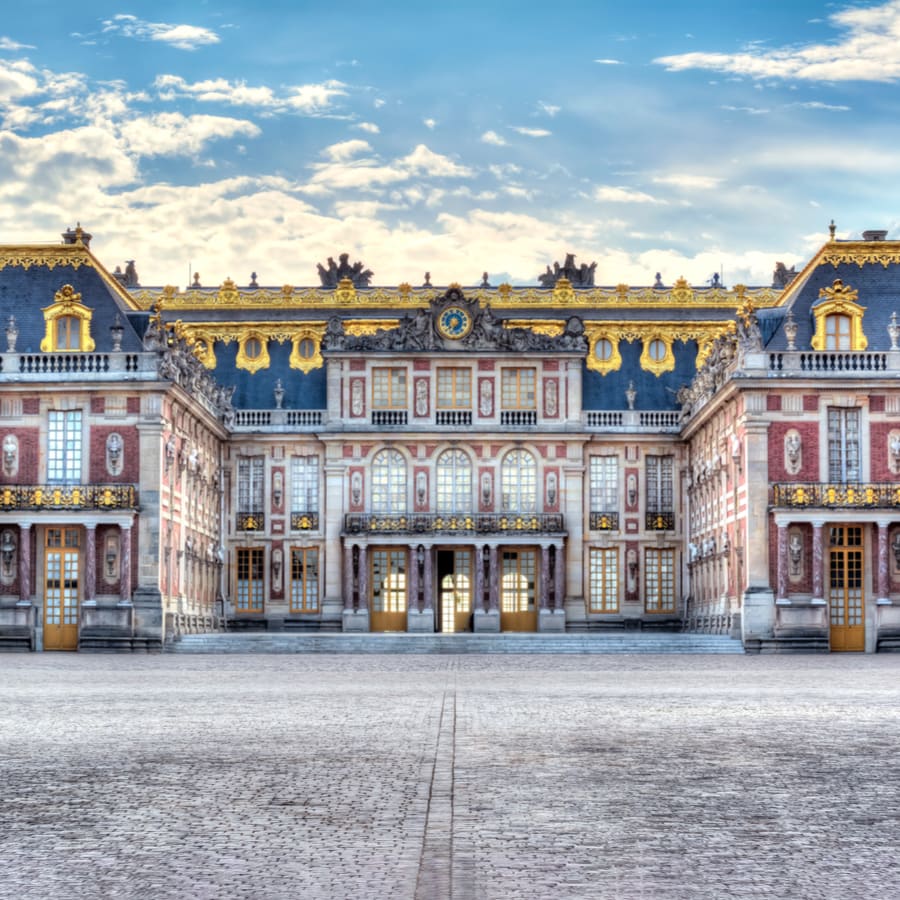
Day 5
Paris
Day 5
Paris


Early Morning to Late Afternoon
Grand & Grand Gardeners, Visiting the Palace of Versailles
The Château of Versailles, a symbol of the grandeur of French monarchy, invites visitors to explore its lavish history and architectural majesty. From the spellbinding elegance of the Hall of Mirrors, where the Treaty of Versailles was signed, to the vast, meticulously manicured Gardens the pinnacle of French garden design, every corner tells a story of opulence and power. Discover the intimate escapes of royalty at the Grand and Petit Trianon, and marvel at the divine beauty of the Royal Chapel, a masterpiece of Baroque architecture.

The Queen's Hamlet
Imagine living like the "peasants" here?
Show More

Parc de Versailles
Feel like a king, feel like a queen, hopefully you'll feel good looking out across the park
Show More

Main Palace of Versailles
There are palaces, and then there is Versailles...
Show More

The Queen's Hamlet
Imagine living like the "peasants" here?
Show More

Parc de Versailles
Feel like a king, feel like a queen, hopefully you'll feel good looking out across the park
Show More

Main Palace of Versailles
There are palaces, and then there is Versailles...
Show More

The Queen's Hamlet
Imagine living like the "peasants" here?
Show More
prev
next

Day 5
Paris

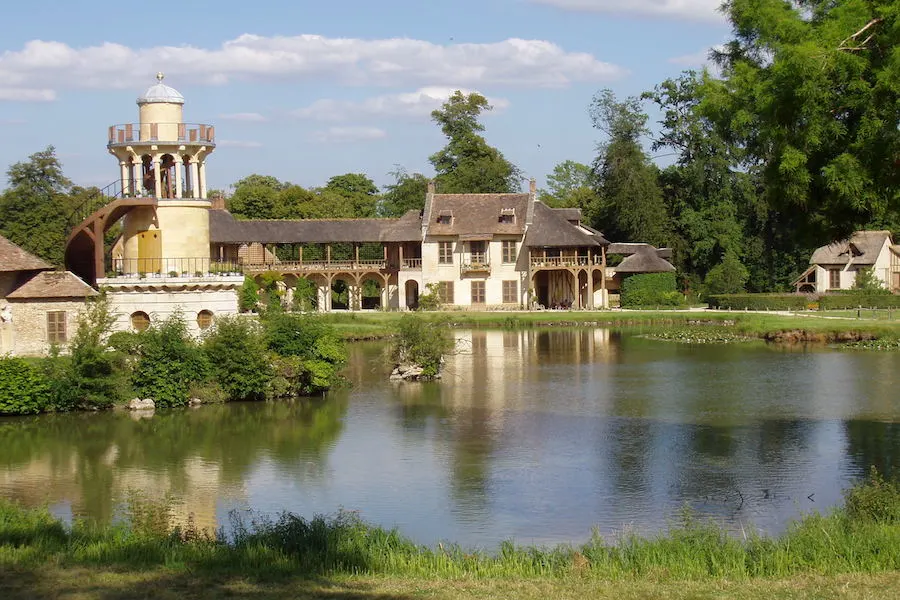
The Queen's Hamlet
 Highlight of Palace of Versailles
Highlight of Palace of VersaillesImagine living like the "peasants" here?
Desiring something different, Queen Marie Antoinette had a hamlet erected where she could supervise servants milking cows, tending pigs, collecting eggs from chickens. She dressed down to play her part, but apparently never got her hands dirty, as far as we know. Her peasant cottage only had two living rooms, a billiard room, a dining hall, and a library. If you are accustomed to palaces, only two living rooms is roughing it. Lest the queen got tired of it all, she could return to the Petit Trianon, a beautiful chateau built on the grounds of the Grand Trianon, which was the retreat chateau built on the grounds of the Palace of Versailles, which was a retreat from the Louvre Palace in Paris.
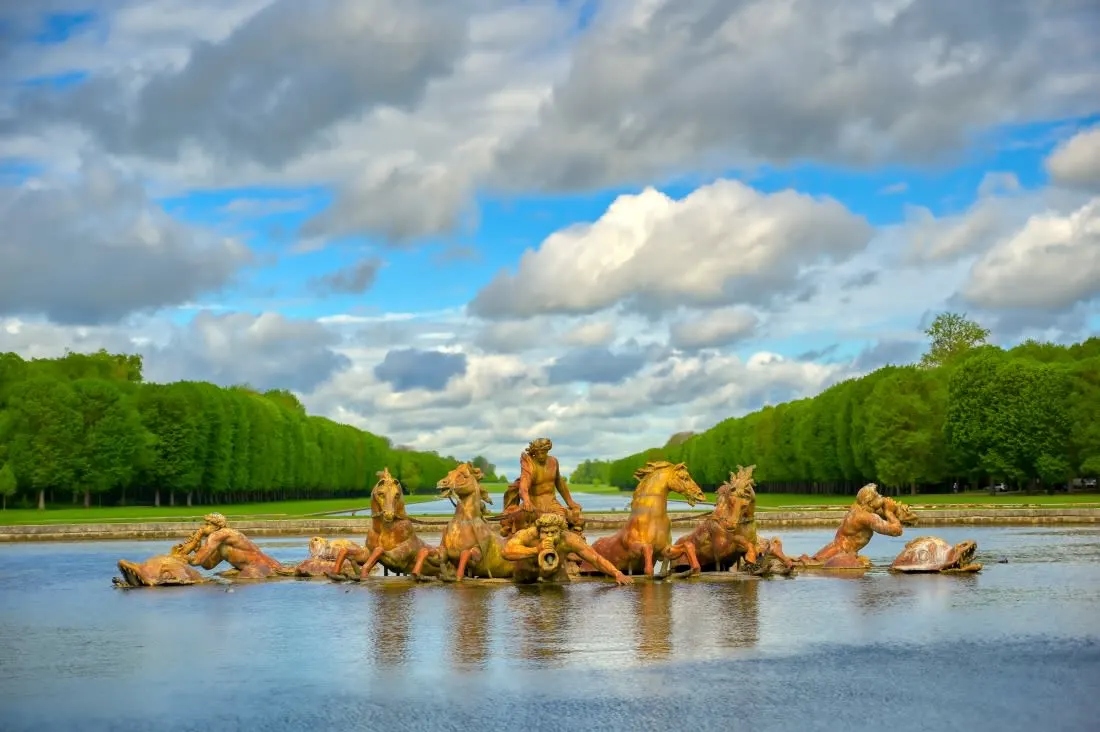
Parc de Versailles
 Highlight of Palace of Versailles
Highlight of Palace of VersaillesFeel like a king, feel like a queen, hopefully you'll feel good looking out across the park
The Parc de Versailles, features some 800 hectares of manicured lawns, stunning fountains, and the Grand Canal, all masterminded by André Le Nôtre. Highlights include the Neptune and Apollo Fountains, the Trianon Palaces, and the Queen's Hamlet. This vast garden symbolizes royal power, but you are welcomed to enjoy yourself on these pleasure grounds.
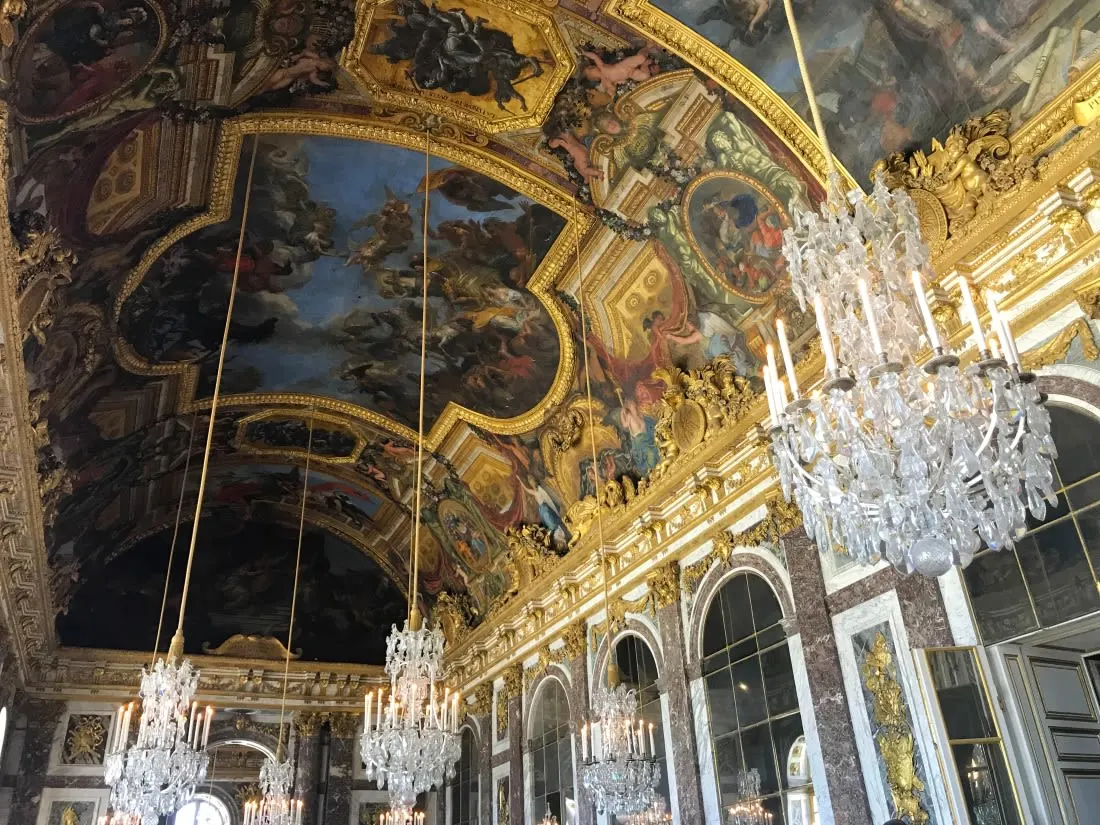
Main Palace of Versailles
 Highlight of Palace of Versailles
Highlight of Palace of VersaillesThere are palaces, and then there is Versailles...
Enlarged by for Emperor Louis XIV as an escape from the dreary political tension of Paris, Versailles might have been the most luxurious palace in the world. Even now, the building stuptifies with its grandeur and elegance, a stunning representation of the French monarchy's opulence. The famous Hall of Mirrors is just one of many, many (2300!) stunning rooms, only a small percentage of which are open for display. It might be too much, or one visit might never be enough.

The Queen's Hamlet
 Highlight of Palace of Versailles
Highlight of Palace of VersaillesImagine living like the "peasants" here?
Desiring something different, Queen Marie Antoinette had a hamlet erected where she could supervise servants milking cows, tending pigs, collecting eggs from chickens. She dressed down to play her part, but apparently never got her hands dirty, as far as we know. Her peasant cottage only had two living rooms, a billiard room, a dining hall, and a library. If you are accustomed to palaces, only two living rooms is roughing it. Lest the queen got tired of it all, she could return to the Petit Trianon, a beautiful chateau built on the grounds of the Grand Trianon, which was the retreat chateau built on the grounds of the Palace of Versailles, which was a retreat from the Louvre Palace in Paris.

Parc de Versailles
 Highlight of Palace of Versailles
Highlight of Palace of VersaillesFeel like a king, feel like a queen, hopefully you'll feel good looking out across the park
The Parc de Versailles, features some 800 hectares of manicured lawns, stunning fountains, and the Grand Canal, all masterminded by André Le Nôtre. Highlights include the Neptune and Apollo Fountains, the Trianon Palaces, and the Queen's Hamlet. This vast garden symbolizes royal power, but you are welcomed to enjoy yourself on these pleasure grounds.

Main Palace of Versailles
 Highlight of Palace of Versailles
Highlight of Palace of VersaillesThere are palaces, and then there is Versailles...
Enlarged by for Emperor Louis XIV as an escape from the dreary political tension of Paris, Versailles might have been the most luxurious palace in the world. Even now, the building stuptifies with its grandeur and elegance, a stunning representation of the French monarchy's opulence. The famous Hall of Mirrors is just one of many, many (2300!) stunning rooms, only a small percentage of which are open for display. It might be too much, or one visit might never be enough.

The Queen's Hamlet
 Highlight of Palace of Versailles
Highlight of Palace of VersaillesImagine living like the "peasants" here?
Desiring something different, Queen Marie Antoinette had a hamlet erected where she could supervise servants milking cows, tending pigs, collecting eggs from chickens. She dressed down to play her part, but apparently never got her hands dirty, as far as we know. Her peasant cottage only had two living rooms, a billiard room, a dining hall, and a library. If you are accustomed to palaces, only two living rooms is roughing it. Lest the queen got tired of it all, she could return to the Petit Trianon, a beautiful chateau built on the grounds of the Grand Trianon, which was the retreat chateau built on the grounds of the Palace of Versailles, which was a retreat from the Louvre Palace in Paris.
prev
next

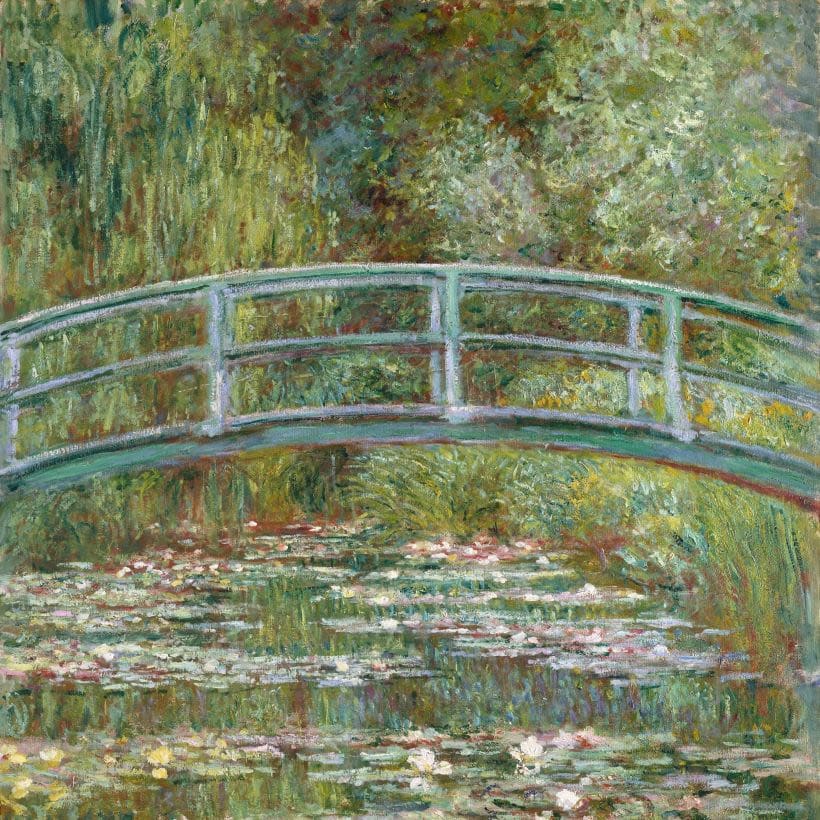
Day 6
Paris to Brussels
Day 6
Paris to Brussels




Morning to Afternoon
Impressions of Beauty Wait in Giverny and Monet Gardens
Inspire your artistic sensibilities in the picturesque village of Giverny and experience the beauty that moved Impressionist painter Claude Monet to live here for over 40 years. Visit the house where this master lived and absorb the serenity of the gardens that inspired many of his paintings, including Water Lilies.

Day 6
Paris to Brussels


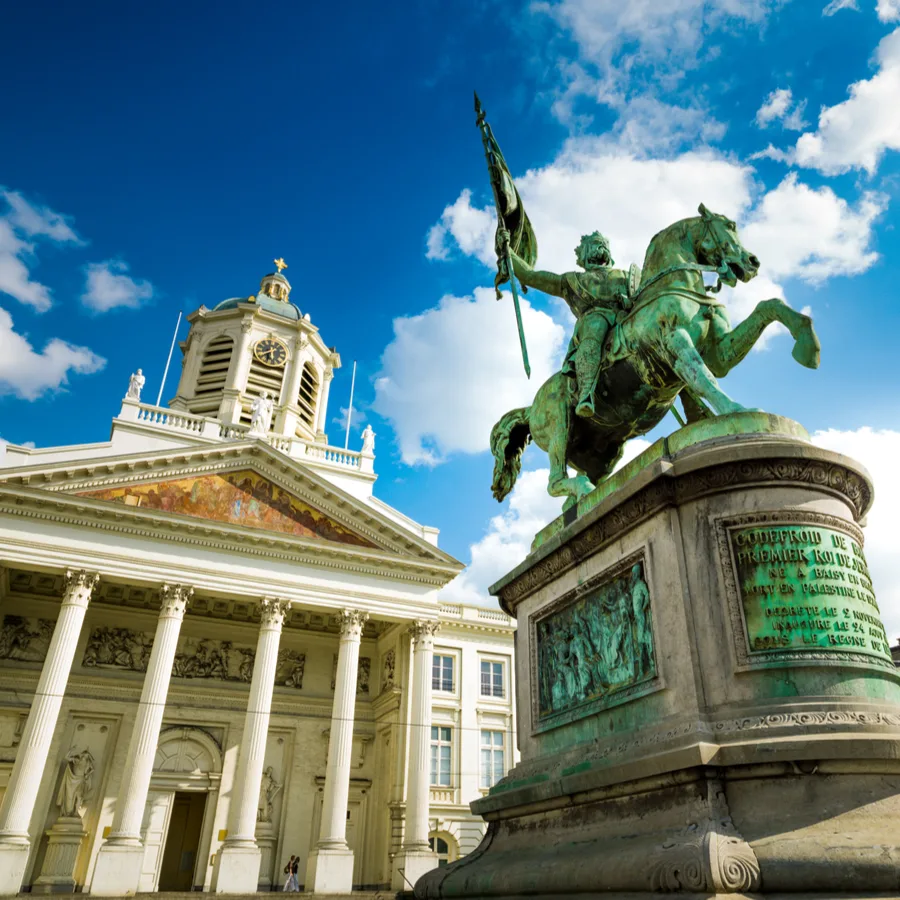
Day 7
Brussels
Day 7
Brussels



9:30 AM - 12:30 PM
Private Guided Walking Tour of Brussels
Discover the history of Brussels and its highlights on this 3-hour tour. Walk through the old town to see the famous Grand-Place, which Victor Hugo called, “the most beautiful square in the world. Nearby you will discover the unofficial symbol of Brussels – Manneken-pis. The tour also includes the halls Saint Géry, the serene royal palace, the Justice Palace, and more. By tour's end you will feel ready to explore Brussels on your own, or prepared for a delicious waffle!

Day 7
Brussels



Day 8
Brussels
Day 8
Brussels



Early Morning to Mid-Day
Self-Guided Excursion to Bruges
By the 14th century, Bruges was one of the largest and most important cities in northern Europe. Often referred to as "Venice of the North," the canals and medieval architecture create a picturesque day trip from Brussels with plenty of things to see and do. Medieval remains in the city include the Market Hall, Belfry Tower and Town Hall. The Chapel of the Holy Blood contains the Chapel of St. Basil and a gold casket that is reputed to hold a few drops of Christ’s blood brought from the Holy Land in 1150. Bruges deserves your attention. This gem of medieval Europe is preserved in every cobblestone and canal. Wander through the enchanting streets of this UNESCO World Heritage city, where every turn reveals architectural marvels and echoes of a rich historical tapestry. Walk across fairy-tale bridges, marvel at the towering belfry that dominates the skyline, and enjoy the illustrious Markt square, pulsating with life and color. Indulge in a hot waffle, savor the world-renowned beers in quaint breweries, and explore the mystical Lake of Love. Let Bruges woo you with its timeless allure.

Historium Bruges
Learn About the Role of Bruges in the Late-Medieval World... It Wasn't a Small Role
Show More

Church of Our Lady Bruges
Crane Your Neck to See the Heights of This Medieval Marvel
Show More

Bruges Markt
Ogle the expressive architecture of the Markt square in Bruges
Show More

Belfry of Bruges
Hear the 47 Chiming Bells of This UNESCO-Heritage Tower
Show More

Historium Bruges
Learn About the Role of Bruges in the Late-Medieval World... It Wasn't a Small Role
Show More

Church of Our Lady Bruges
Crane Your Neck to See the Heights of This Medieval Marvel
Show More

Bruges Markt
Ogle the expressive architecture of the Markt square in Bruges
Show More

Belfry of Bruges
Hear the 47 Chiming Bells of This UNESCO-Heritage Tower
Show More
prev
next

Day 8
Brussels


Historium Bruges
 Highlight of Bruges, Self-Guided
Highlight of Bruges, Self-GuidedLearn About the Role of Bruges in the Late-Medieval World... It Wasn't a Small Role
The Historium Bruges is an immersive attraction located in the Market Square that transports visitors to the 15th century, showcasing the city's Golden Age. Through virtual reality, recreated scenes, and storytelling, it highlights Bruges as a vibrant medieval trade and cultural center. The experience is enhanced by panoramic views of the Market Square from the Historium's terrace, making it a key destination for those interested in exploring the historical depth of Bruges.

Church of Our Lady Bruges
 Highlight of Bruges, Self-Guided
Highlight of Bruges, Self-GuidedCrane Your Neck to See the Heights of This Medieval Marvel
The Church of Our Lady in Bruges, a towering example of Gothic architecture, is notable for its height, and it even houses a Michelangelo sculpture of the Madonna and Child, a rarity outside Italy. Dating back to the 13th-century, it contains the tombs of the heroic Charles the Bold and Mary of Burgundy, among other art treasures. Its serene interior, with vaulted ceilings and stained glass, draws visitors into its history and spirit.

Bruges Markt
 Highlight of Bruges, Self-Guided
Highlight of Bruges, Self-GuidedOgle the expressive architecture of the Markt square in Bruges
The Markt of Bruges is the city's historic heart, featuring the towering, medieval Belfry, ornate guild houses, and a statue symbolizing independence, all accompanied by vibrant shops and cafes. This square wears Bruges' medieval history on its sleeve, drawing tourists and locals alike to its sights.
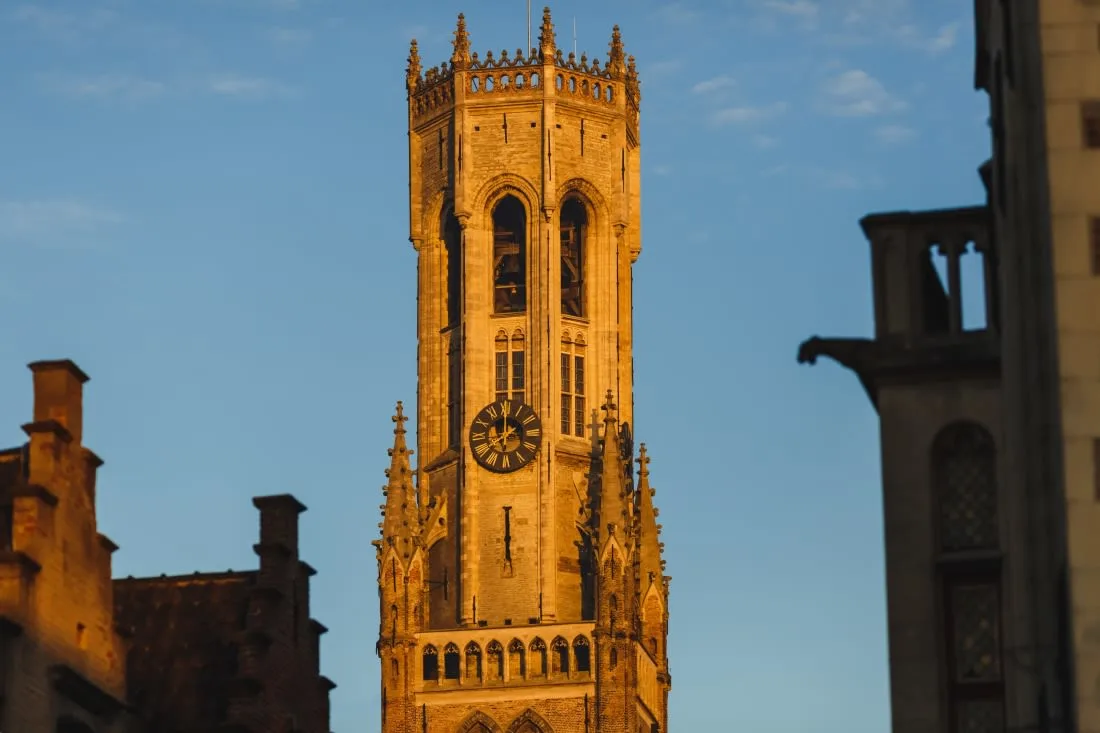
Belfry of Bruges
 Highlight of Bruges, Self-Guided
Highlight of Bruges, Self-GuidedHear the 47 Chiming Bells of This UNESCO-Heritage Tower
The Belfry of Bruges stands as a central landmark in the historic heart of Bruges. This iconic structure, soaring 83 meters into the sky, draws visitors back into the Middle Ages. Climbing its 366 steps rewards with breathtaking panoramic views of the city's cobblestone streets and charming canals. The Belfry traditionally housed the city archives and served as a treasury. Its carillon, comprising 47 melodious bells, continues to enchant the city's air. It also plays a central role in the film In Bruges.

Historium Bruges
 Highlight of Bruges, Self-Guided
Highlight of Bruges, Self-GuidedLearn About the Role of Bruges in the Late-Medieval World... It Wasn't a Small Role
The Historium Bruges is an immersive attraction located in the Market Square that transports visitors to the 15th century, showcasing the city's Golden Age. Through virtual reality, recreated scenes, and storytelling, it highlights Bruges as a vibrant medieval trade and cultural center. The experience is enhanced by panoramic views of the Market Square from the Historium's terrace, making it a key destination for those interested in exploring the historical depth of Bruges.

Church of Our Lady Bruges
 Highlight of Bruges, Self-Guided
Highlight of Bruges, Self-GuidedCrane Your Neck to See the Heights of This Medieval Marvel
The Church of Our Lady in Bruges, a towering example of Gothic architecture, is notable for its height, and it even houses a Michelangelo sculpture of the Madonna and Child, a rarity outside Italy. Dating back to the 13th-century, it contains the tombs of the heroic Charles the Bold and Mary of Burgundy, among other art treasures. Its serene interior, with vaulted ceilings and stained glass, draws visitors into its history and spirit.

Bruges Markt
 Highlight of Bruges, Self-Guided
Highlight of Bruges, Self-GuidedOgle the expressive architecture of the Markt square in Bruges
The Markt of Bruges is the city's historic heart, featuring the towering, medieval Belfry, ornate guild houses, and a statue symbolizing independence, all accompanied by vibrant shops and cafes. This square wears Bruges' medieval history on its sleeve, drawing tourists and locals alike to its sights.

Belfry of Bruges
 Highlight of Bruges, Self-Guided
Highlight of Bruges, Self-GuidedHear the 47 Chiming Bells of This UNESCO-Heritage Tower
The Belfry of Bruges stands as a central landmark in the historic heart of Bruges. This iconic structure, soaring 83 meters into the sky, draws visitors back into the Middle Ages. Climbing its 366 steps rewards with breathtaking panoramic views of the city's cobblestone streets and charming canals. The Belfry traditionally housed the city archives and served as a treasury. Its carillon, comprising 47 melodious bells, continues to enchant the city's air. It also plays a central role in the film In Bruges.
prev
next


Day 9
Brussels to Amsterdam
Day 9
Brussels to Amsterdam





Early Morning/Morning
Chocolate or Waffle Workshop
Both Chocolate and Waffles have found a unique identity within Belgium. A two-and-a-half hour waffle-making workshop or a 90 minute chocolate-making workshop gives you a hands-on experience for two of Belgium's most iconic foodstuffs. Back home, friends and family will appreciate your new-found talents. Please choose which workshop you'd prefer from the information contained in the Full Itinerary.

Day 9
Brussels to Amsterdam



Day 10
Amsterdam
Day 10
Amsterdam



9:00 AM - 1:00 PM
Privately Guided Walking Tour of Amsterdam
Enjoy an introduction to Amsterdam with this 4-hour private guided walking tour. After picking you up from your hotel, your professional guide will lead you past many of the city's highlights, including its center, as well as the Jordaan, the Grachtengordel, and the infamous Red-Light District. The guide will explain how all these feature in the city's history and contemporary life. Your guide will be happy to share some great tips for the rest of your stay.

Day 10
Amsterdam


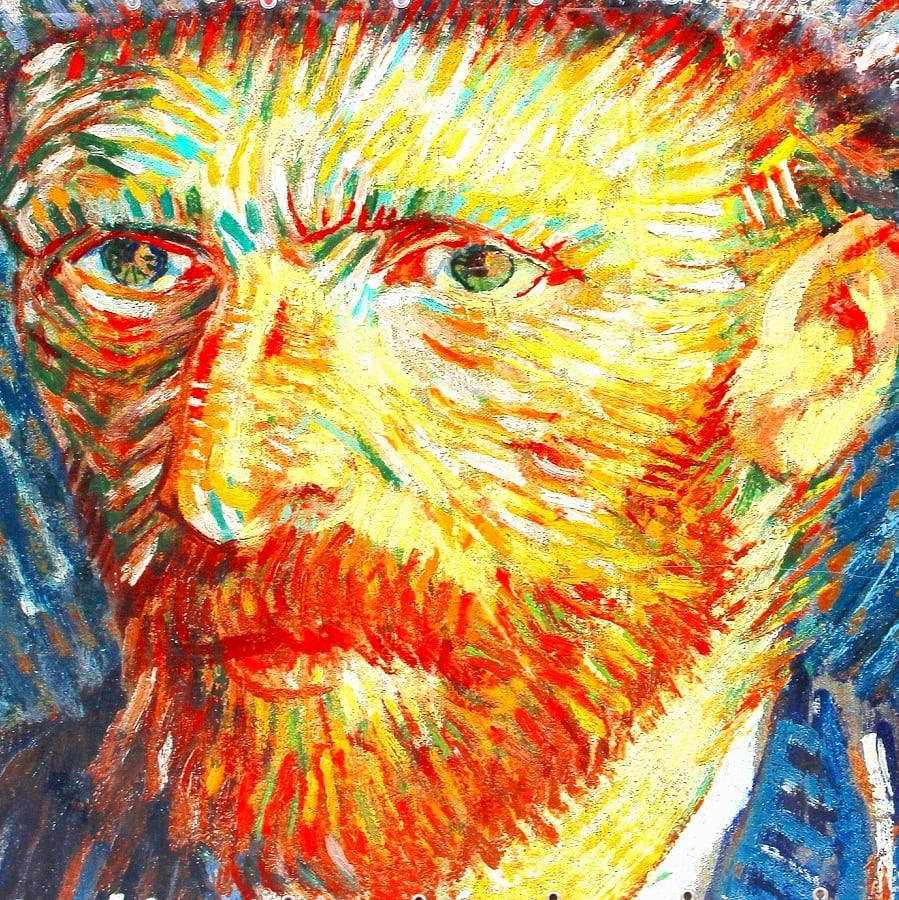
Day 11
Amsterdam
Day 11
Amsterdam


Morning to Afternoon
Impress yourself in the Museum Quarter
Arranged in a tight knot on the aptly named Museumplein, Amsterdam's premier world-class museums include the Van Gogh Museum (pre-booked tickets required), the Rijks Museum with its collection of Rembrandts, and the Stedelijk Museum of modern and contemporary art. The Amsterdam Diamond Museum is nearby as well. Choose to visit one or more of these wonderful cultural venues from the detailed descriptions provided in the Full Itinerary.

Moco Museum
Contemporary in an Old City Can Be Beautiful Too
Show More

Diamond Museum
This museum will defintely make your eyes sparkle.
Show More

Rijks Museum Shop
Find Tickets and Trinkets related to the Rijks- and Van Gogh Museums
Show More

Van Gogh Museum
The Van Gogh Museum - How Can't You Be Impressed?
Show More

Moco Museum
Contemporary in an Old City Can Be Beautiful Too
Show More

Diamond Museum
This museum will defintely make your eyes sparkle.
Show More

Rijks Museum Shop
Find Tickets and Trinkets related to the Rijks- and Van Gogh Museums
Show More

Van Gogh Museum
The Van Gogh Museum - How Can't You Be Impressed?
Show More
prev
next

Day 11
Amsterdam


Moco Museum
 Highlight of Museum Quarter
Highlight of Museum QuarterContemporary in an Old City Can Be Beautiful Too
The MoCo Museum dedicates itself to showcasing modern, cutting-edge works from some of the most influential artists of the 20th and 21st centuries. Situated in a renovated townhouse in the heart of Amsterdam, it offers a dynamic and engaging art experience, featuring both permanent and temporary exhibitions. Highlights include pieces by Maria Abramović, Banksy, Andy Warhol, and other iconic figures who have shaped the contemporary art scene. The museum's intimate scale allows for a personal exploration of the artworks

Diamond Museum
 Highlight of Museum Quarter
Highlight of Museum QuarterThis museum will defintely make your eyes sparkle.
The Diamant Museum in Amsterdam delves into this dazzling gem's history, highlighting Amsterdam's significance in the diamond industry since the 16th century. Simultaneously, it showcases its journey from raw stones to exquisite jewelry, emphasizing the art of diamond cutting and polishing, and, of course, features a collection of gems and artifacts,.
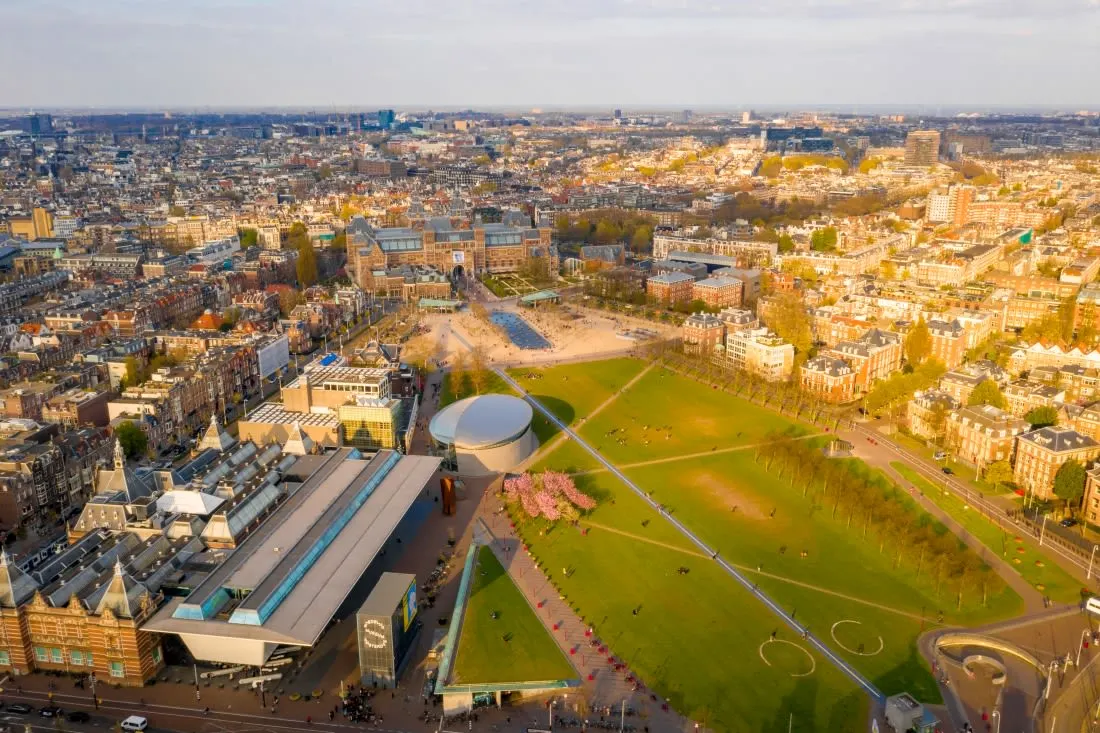
Rijks Museum Shop
 Highlight of Museum Quarter
Highlight of Museum QuarterFind Tickets and Trinkets related to the Rijks- and Van Gogh Museums
Located on Museumplein (Museum Square), this convienent shop is operated by both museums to contend with the overflow at their respective ticket offices. Even this shop can become busy. However, if you don't plan on visiting the museums, but still want to pick up some souvenirs, this is your spot: both museums supply this store with their own merchandise.
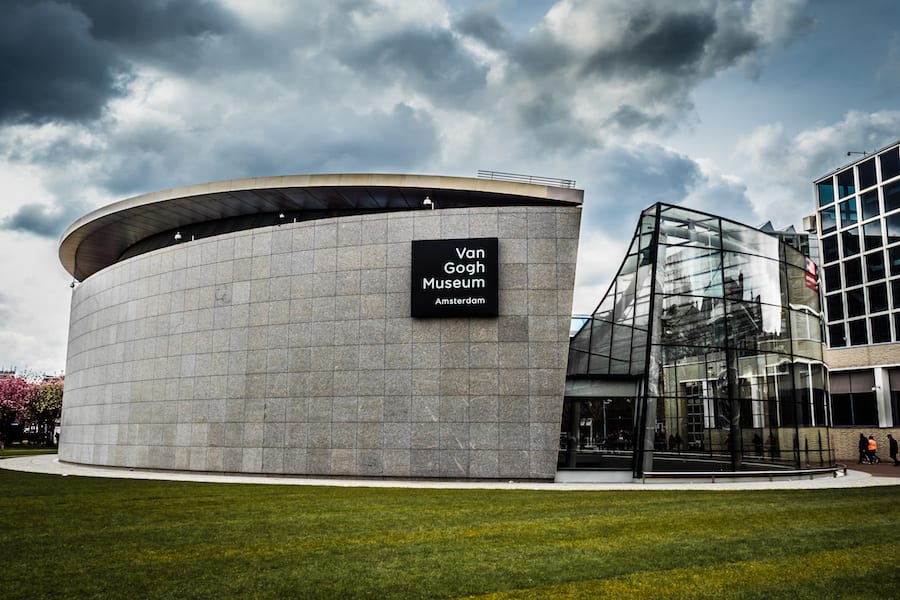
Van Gogh Museum
 Highlight of Museum Quarter
Highlight of Museum QuarterThe Van Gogh Museum - How Can't You Be Impressed?
Maybe no other artist since Michelangelo has touched the Western World as deeply as Vincent Van Gogh. His exhuberent palates of color, the frenetic pace at which he painted, the humanity of his subjects, not to mention the pathos of his own life, all combined to make unforgettable works - many of whic hare at this museum. Millions of words have been written about the man and his art; but somehow, seeing them live often leaves a person speechless.

Moco Museum
 Highlight of Museum Quarter
Highlight of Museum QuarterContemporary in an Old City Can Be Beautiful Too
The MoCo Museum dedicates itself to showcasing modern, cutting-edge works from some of the most influential artists of the 20th and 21st centuries. Situated in a renovated townhouse in the heart of Amsterdam, it offers a dynamic and engaging art experience, featuring both permanent and temporary exhibitions. Highlights include pieces by Maria Abramović, Banksy, Andy Warhol, and other iconic figures who have shaped the contemporary art scene. The museum's intimate scale allows for a personal exploration of the artworks

Diamond Museum
 Highlight of Museum Quarter
Highlight of Museum QuarterThis museum will defintely make your eyes sparkle.
The Diamant Museum in Amsterdam delves into this dazzling gem's history, highlighting Amsterdam's significance in the diamond industry since the 16th century. Simultaneously, it showcases its journey from raw stones to exquisite jewelry, emphasizing the art of diamond cutting and polishing, and, of course, features a collection of gems and artifacts,.

Rijks Museum Shop
 Highlight of Museum Quarter
Highlight of Museum QuarterFind Tickets and Trinkets related to the Rijks- and Van Gogh Museums
Located on Museumplein (Museum Square), this convienent shop is operated by both museums to contend with the overflow at their respective ticket offices. Even this shop can become busy. However, if you don't plan on visiting the museums, but still want to pick up some souvenirs, this is your spot: both museums supply this store with their own merchandise.

Van Gogh Museum
 Highlight of Museum Quarter
Highlight of Museum QuarterThe Van Gogh Museum - How Can't You Be Impressed?
Maybe no other artist since Michelangelo has touched the Western World as deeply as Vincent Van Gogh. His exhuberent palates of color, the frenetic pace at which he painted, the humanity of his subjects, not to mention the pathos of his own life, all combined to make unforgettable works - many of whic hare at this museum. Millions of words have been written about the man and his art; but somehow, seeing them live often leaves a person speechless.
prev
next

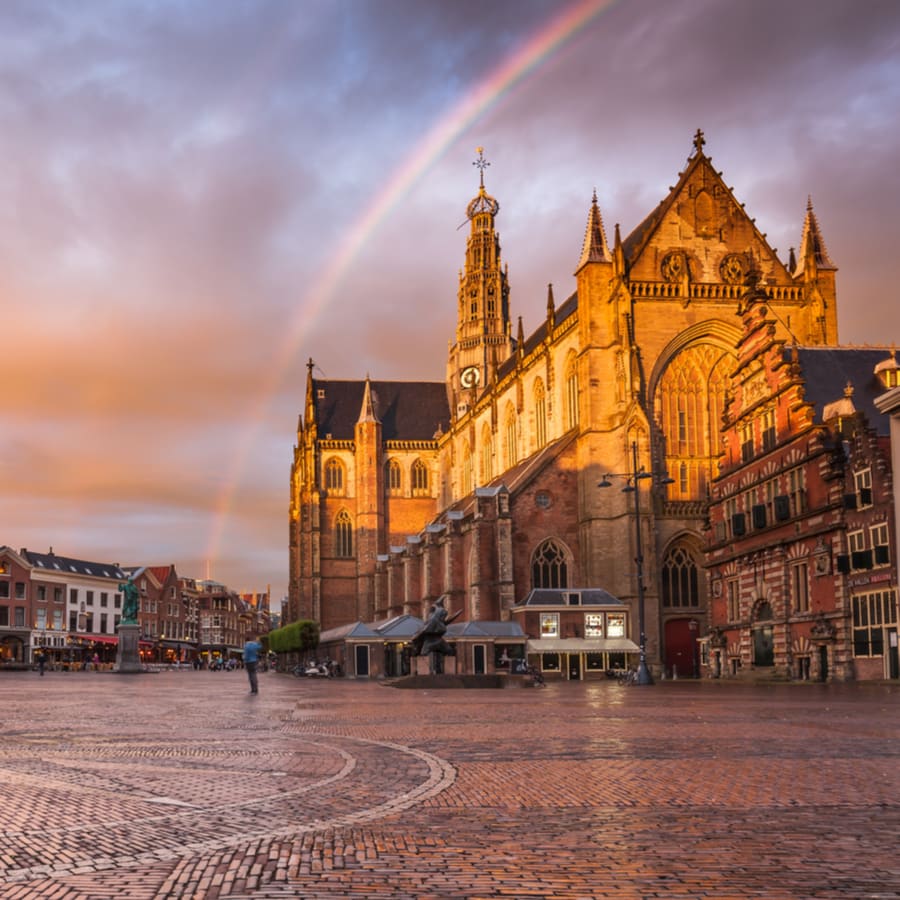
Day 12
Amsterdam
Day 12
Amsterdam



Morning to Late Afternoon
Self-Guided Tour of Haarlem
Haarlem, only a short 20-minute train ride away from the hustle and bustle of Amsterdam, is celebrated for its medieval architecture, cultural vibrancy, and historical significance as North Holland's capital. Home to the majestic Grote Kerk, the city's Grote Markt serves as a focal point surrounded by historical buildings. Famous for its contribution to the 17th-century tulip mania and picturesque canals, Haarlem offers a blend of art, history, and natural beauty, making it an enriching visit with a quiet charm.

Windmill De Adriaan
Enjoy this quintessential windmill in Haarlem...
Show More

Grote Kerk, Zwolle
A Swell Tower and Church in Zwolle
Show More

Teylers Museum
Enlighten Yourself with a Wise Visit to this Enlightenment Museum
Show More

Windmill De Adriaan
Enjoy this quintessential windmill in Haarlem...
Show More

Grote Kerk, Zwolle
A Swell Tower and Church in Zwolle
Show More

Teylers Museum
Enlighten Yourself with a Wise Visit to this Enlightenment Museum
Show More

Windmill De Adriaan
Enjoy this quintessential windmill in Haarlem...
Show More
prev
next

Day 12
Amsterdam


Windmill De Adriaan
 Highlight of Haarlem, Self-Guided
Highlight of Haarlem, Self-GuidedEnjoy this quintessential windmill in Haarlem...
... And the story of its place in the hearts of locals. Windmill De Adriaan, perched on the banks of the River Spaarne in Haarlem, is a striking landmark that offers a glimpse into Dutch windmill engineering since its original construction in 1779. Though it was rebuilt in 2002 after a devastating fire decades before, De Adriaan retains its historic charm and functionality, demonstrating traditional milling techniques used for various purposes, including producing paint, tobacco, and flour. Visitors can explore the interior through guided tours, learning about the windmill's mechanics and its role in Dutch culture and industry.

Grote Kerk, Zwolle
 Highlight of Haarlem, Self-Guided
Highlight of Haarlem, Self-GuidedA Swell Tower and Church in Zwolle
The Grote Kerk (St. Michael's Church) in Zwolle, notable for its late Gothic architecture, dates back to the 15th century. Though its tower was aimed to outdo Utrecht's Dom Tower, it remains unfinished thanks to a series of lightning strikes. The church's interior features a carved pulpit, an ornate organ, and beautiful stained glass windows. The church has indirectly given Zwolle's inhabitants their nickname, Blauwvingers (Bluefingers). For once, a Dutch story that doesn't reward frugality.

Teylers Museum
 Highlight of Haarlem, Self-Guided
Highlight of Haarlem, Self-GuidedEnlighten Yourself with a Wise Visit to this Enlightenment Museum
The Teylers Museum in Haarlem, Netherlands, is a remarkable journey back into the Age of Enlightenment, where art and science converge in the oldest museum in the country. Established in 1784, it houses an eclectic collection ranging from rare books and fossils to historical scientific instruments and works by great masters like Michelangelo and Rembrandt. The museum's unique atmosphere is enhanced by its preserved 18th-century interior, offering visitors a genuine experience of stepping back in time.

Windmill De Adriaan
 Highlight of Haarlem, Self-Guided
Highlight of Haarlem, Self-GuidedEnjoy this quintessential windmill in Haarlem...
... And the story of its place in the hearts of locals. Windmill De Adriaan, perched on the banks of the River Spaarne in Haarlem, is a striking landmark that offers a glimpse into Dutch windmill engineering since its original construction in 1779. Though it was rebuilt in 2002 after a devastating fire decades before, De Adriaan retains its historic charm and functionality, demonstrating traditional milling techniques used for various purposes, including producing paint, tobacco, and flour. Visitors can explore the interior through guided tours, learning about the windmill's mechanics and its role in Dutch culture and industry.

Grote Kerk, Zwolle
 Highlight of Haarlem, Self-Guided
Highlight of Haarlem, Self-GuidedA Swell Tower and Church in Zwolle
The Grote Kerk (St. Michael's Church) in Zwolle, notable for its late Gothic architecture, dates back to the 15th century. Though its tower was aimed to outdo Utrecht's Dom Tower, it remains unfinished thanks to a series of lightning strikes. The church's interior features a carved pulpit, an ornate organ, and beautiful stained glass windows. The church has indirectly given Zwolle's inhabitants their nickname, Blauwvingers (Bluefingers). For once, a Dutch story that doesn't reward frugality.

Teylers Museum
 Highlight of Haarlem, Self-Guided
Highlight of Haarlem, Self-GuidedEnlighten Yourself with a Wise Visit to this Enlightenment Museum
The Teylers Museum in Haarlem, Netherlands, is a remarkable journey back into the Age of Enlightenment, where art and science converge in the oldest museum in the country. Established in 1784, it houses an eclectic collection ranging from rare books and fossils to historical scientific instruments and works by great masters like Michelangelo and Rembrandt. The museum's unique atmosphere is enhanced by its preserved 18th-century interior, offering visitors a genuine experience of stepping back in time.

Windmill De Adriaan
 Highlight of Haarlem, Self-Guided
Highlight of Haarlem, Self-GuidedEnjoy this quintessential windmill in Haarlem...
... And the story of its place in the hearts of locals. Windmill De Adriaan, perched on the banks of the River Spaarne in Haarlem, is a striking landmark that offers a glimpse into Dutch windmill engineering since its original construction in 1779. Though it was rebuilt in 2002 after a devastating fire decades before, De Adriaan retains its historic charm and functionality, demonstrating traditional milling techniques used for various purposes, including producing paint, tobacco, and flour. Visitors can explore the interior through guided tours, learning about the windmill's mechanics and its role in Dutch culture and industry.
prev
next


Day 13
Amsterdam
Day 13
Amsterdam


Early Morning/Morning
Self-Guided Excursion to Zaanse Schans
Zaanse Schans is one of the most popular day trips from Amsterdam, a panorama of features deemed quintessentially Dutch like windmills and wooden clogs. This well-preserved neighborhood feels like an open-air museum full of traditional Dutch handicrafts as the bakery museum offers freshly baked cookies and their free aromas. Clogs are still hewn here. You should not to miss the cheese factory, pewter foundry and the various windmills. In guarding these traditions Zaanse Schans has become immensely popular, and crowded at times. The neighborhood can seem a bit fantastical, and sometimes we want that on a holiday.

Day 13
Amsterdam



Day 14
Depart Amsterdam
Day 14
Depart Amsterdam

To Be Determined
Transfer to Airport by Taxi
Amsterdam has one main airport, Amsterdam Airport Schiphol. The most affordable and often fastest way to reach the airport is by train. Local direct trains to the airport depart every ten minutes, usually from platform 14a or platform 15, and get you there in about 20 minutes. Your hotel can arrange a reliable taxi or if you have the app, Uber is also a good option. You can also arrange a private transfer. If you are picked up about two hours and 45 minutes before your departure time, you should arrive at the airport with about two hours to spare, depending on traffic. If you are leaving during rush hour, you may want to budget an extra fifteen to thirty minutes.

Day 14
Depart Amsterdam


What's Included In Your Trip

Pre-Paid Tours and Activities:
- Private Guided Walking Tour of the Center of Paris
- Private Guided Walking Tour of Brussels
- Privately Guided Walking Tour of Amsterdam
- Guided Visit to Anne Frank House & Jewish Quarter
- Canal Cruise in Amsterdam

Pre-Paid Transportation:
- 2nd Class Train Tickets from Paris-Brussels
- 2nd Class Train Tickets from Brussels-Amsterdam
- Public Transport Tickets for Amsterdam

Accommodation:
- 6 nights at a hotel of your choice in Paris
- 4 nights at a hotel of your choice in Brussels
- 6 nights at a hotel of your choice in Amsterdam

Go Real Travel Mobile App:
- Itinerary Plan & Reservations Info
- Points of Interest
- Detailed Travel Information
- Maps & Directions
Other Trips You May Like

10 Days
From$2995USD

14 Days
From$4550USD
A Taste of Northern Europe: A 14-day trip from Brussels to Copenhagen

Belgium, Netherlands, Germany, Denmark

10 Days
From$3099USD
A Journey Through Culture and Time in Paris, Amsterdam, and Germany

France, Netherlands, Germany

21 Days
From$5789USD
Jewels of Europe: Art, History and Waterways in Paris, Amsterdam, Berlin, Prague, Vienna & Budapest

France, Netherlands, Germany, Czech Republic, Austria, Hungary

9 Days
From$2829USD

17 Days
From$4530.9234235USD

7 Days
From$2079USD

10 Days
From$2980USD

13 Days
From$3699USD

10 Days
From$2995USD

14 Days
From$4550USD
A Taste of Northern Europe: A 14-day trip from Brussels to Copenhagen

Belgium, Netherlands, Germany, Denmark

10 Days
From$3099USD
A Journey Through Culture and Time in Paris, Amsterdam, and Germany

France, Netherlands, Germany

21 Days
From$5789USD
Jewels of Europe: Art, History and Waterways in Paris, Amsterdam, Berlin, Prague, Vienna & Budapest

France, Netherlands, Germany, Czech Republic, Austria, Hungary

9 Days
From$2829USD

17 Days
From$4530.9234235USD

7 Days
From$2079USD

10 Days
From$2980USD

13 Days
From$3699USD
prev
next
Featured Blogs
prev
next
Our Customers Say It Best
Marianne Strydom, Paarl, South Africa
I just wanted to thank you for organizing an amazing trip for me – I packed in so much in such a short period of time and everything was just perfect. The way you do things makes it possible to really get to know the destination, which for me as a travel agent could not have been better. 

Otto Chuy, Los Angeles, California
I am still surprised how everything worked as planned, without a hitch. All instructions in your itinerary were precise and correct. Your suggestions and comments in each of the locations we went to were very helpful. All your guides, without exception, were wonderful and exactly on time. 

Malini Dutta, Boston, Massachusetts
We can't thank you enough for the detailed plans, maps, and suggestions. It really felt that someone was holding our hands and showing us around. We had all the excitement of discovering foreign lands, with none of the problems that can happen while negotiating unfamiliar places. In fact, all the cities felt like home within a few hours of arriving and exploring. 

Bev and Mark Frankel, Williamsburg, Virginia
We could not be more pleased with Go Real Travel! You took the guess work out of things like public transport but still managed to allow us the freedom to tour as we wanted. Our guides were exceptional and every time I saw a Viking Cruise tour of 25 people, I realized the quality experience we were getting with Go Real. 

Marianne Strydom, Paarl, South Africa
I just wanted to thank you for organizing an amazing trip for me – I packed in so much in such a short period of time and everything was just perfect. The way you do things makes it possible to really get to know the destination, which for me as a travel agent could not have been better. 

Otto Chuy, Los Angeles, California
I am still surprised how everything worked as planned, without a hitch. All instructions in your itinerary were precise and correct. Your suggestions and comments in each of the locations we went to were very helpful. All your guides, without exception, were wonderful and exactly on time. 

Malini Dutta, Boston, Massachusetts
We can't thank you enough for the detailed plans, maps, and suggestions. It really felt that someone was holding our hands and showing us around. We had all the excitement of discovering foreign lands, with none of the problems that can happen while negotiating unfamiliar places. In fact, all the cities felt like home within a few hours of arriving and exploring. 

Bev and Mark Frankel, Williamsburg, Virginia
We could not be more pleased with Go Real Travel! You took the guess work out of things like public transport but still managed to allow us the freedom to tour as we wanted. Our guides were exceptional and every time I saw a Viking Cruise tour of 25 people, I realized the quality experience we were getting with Go Real. 



Explore cities in more detail

Bayeux
Bayeux is an old, well-preserved town in Normandy. Most known as the backdrop for the Battle of Normandy, visitors who descend from WWII veterans often feel a special, somber connection to this part of France. On June 6, 1944, otherwise known as ‘D-Day’, thousands of Allied troops landed on Normandy’s Atlantic Coast, with a mission to drive out the German occupying forces. More than 120,000 Allied soldiers died in combat over the next three months. Although victorious, the campaign for Normandy caused the highest number of losses for America in all of WWII. A landscape of remembrance, on a tour of the Norman countryside you’ll see the remains of tanks, aircraft, and military bunkers. Special cemeteries and memorials in the area pay tribute to the sacrifice of fallen soldiers. Despite the destruction of nearly every neighboring village, the town of Bayeux endured WWII unscathed. Along with all its medieval architecture, the town’s most precious treasure, the Bayeux Tapestry, was miraculously spared. Stitched in the 11th century, the Tapestry tells the story of William the Conqueror’s invasion of England in 1066. As you view the tapestry and stroll through the charming streets of Bayeux, the sweeping cathedral spires and gently flowing River Aure cast you back to another time. A landscape of war, but also remembrance, a trip to Bayeux and Normandy will deepen your appreciation and respect for the past.

Learn About Bayeux
Build Bayeux Trip
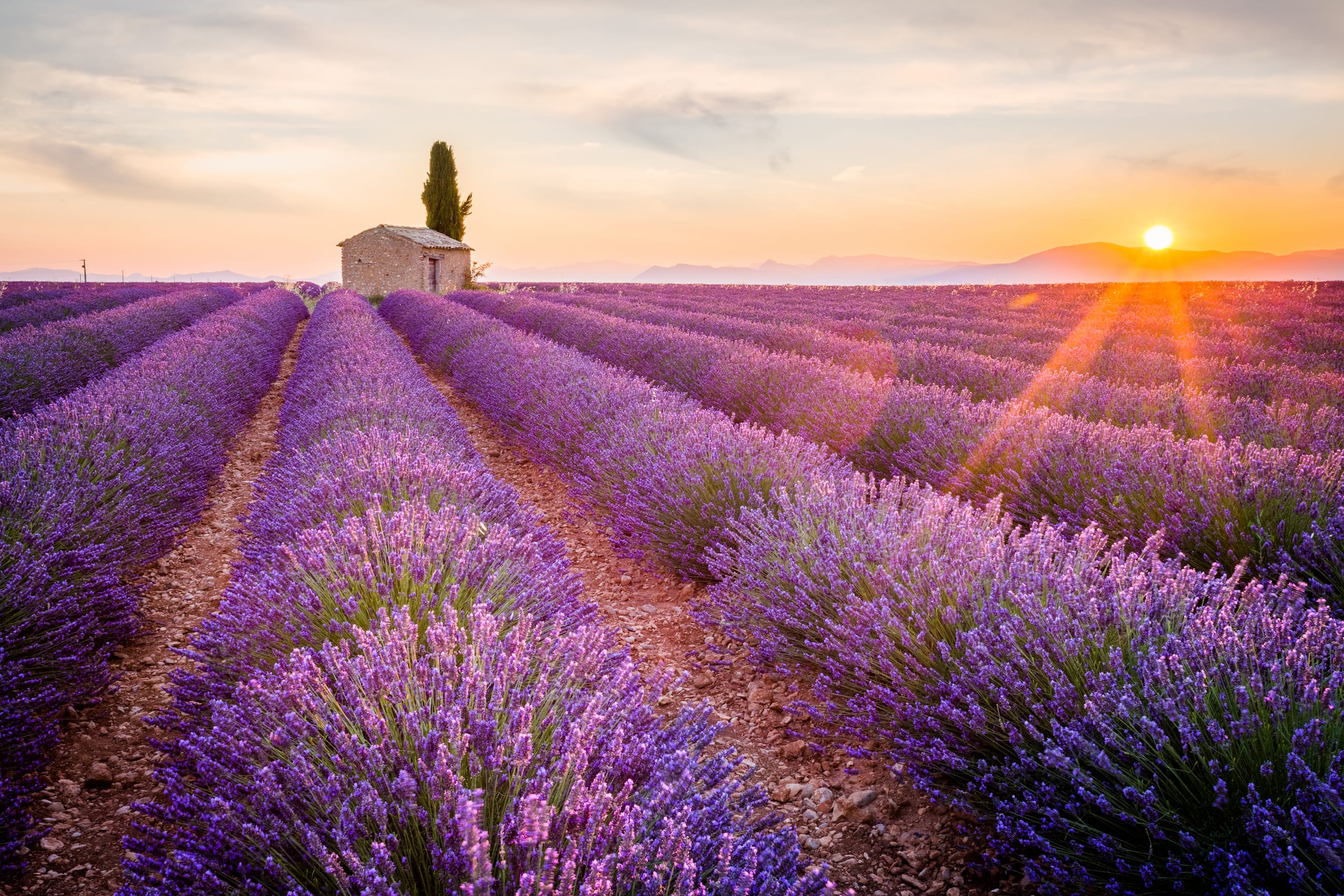
Aix en Provence
Aix en Provence is a warm city baked into the Provence-Alpes-Côte region of Southern France. Often referred to as simply ‘Aix’, this city is a starting point for traveling the Provencal region. Aix is set amongst a backdrop of rambling vineyards, quaint villages, and the imposing Sainte-Victoire mountain range. It’s no surprise that artists like Cézanne have devoted lifetimes to painting this landscape. Aromatic lavender fields in the north blossom once a year with a scent that defines the French countryside. Head south and you’ll find the rocky Mediterranean shore with dramatic Calanques cliffs and clear blue waters. With the sun out nearly all year round, locals live the epitome of the Mediterranean lifestyle. Wander through narrow medieval streets, shop at lively marketplaces, and enjoy a glass of rosé on a cafe terrace beneath the gentle Provencal sun. From old-world architecture and bubbling fountains to refined galleries and leafy parks, this leisurely city has everything you could ask of a French vacation.

Learn About Aix en Provence
Build Aix en Provence Trip
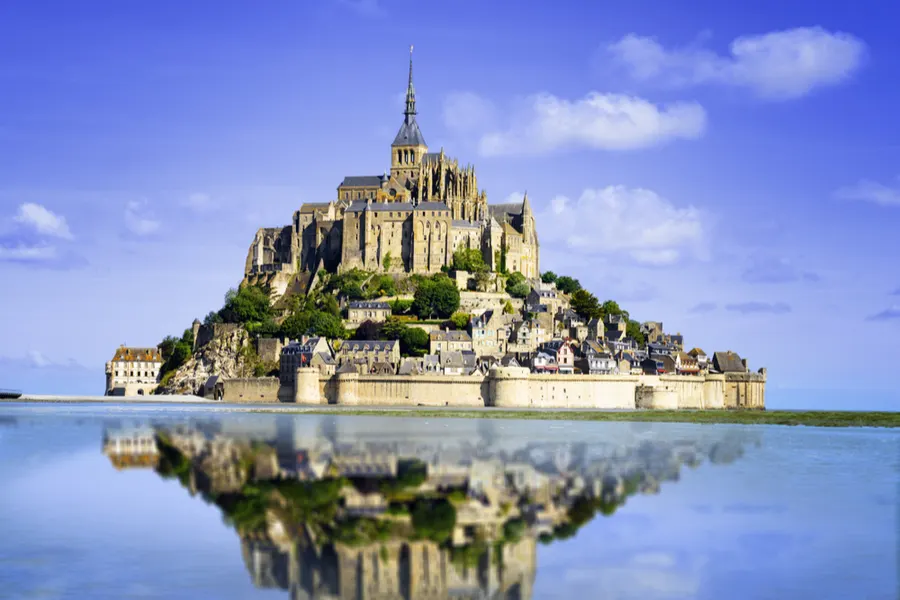
Rennes
Rennes is the capital of Brittany, the most northwest region in France. A sea and countryside getaway, Brittany is famous for its medieval towns, ancient rocky landscapes, and seaside villages. Dotted along the blue-green Atlantic coastline, towns like St. Malo, Dinard, and Cancale are long-time summer vacation spots for the French. Needless to say, you have to try the fresh seafood. Offshore, the island of Mont-Saint-Michel rests dreamily amongst the waves. One of the most beloved UNESCO heritage sites in France, this medieval abbey is connected to the mainland by a bridge over a causeway. Heading inland, there are centuries-old churches, stone cottages, and castles that belonged to Brittany’s medieval royalty, who were known for constantly feuding over successions. The river town of Dinan is surrounded by a fortress wall, a must-see for both its history and profound beauty. In Rennes, half-timbered houses and cobbled streets give way to some of the oldest marketplaces in France. Rennes itself is a tranquil, medium-sized city, easily explored in half a day. In the evening, the city’s gastronomic scene invites you to try local specialties - pancakes, such as savory stuffed galettes and thin, lemony crêpes, are the order of the day here.

Learn About Rennes
Build Rennes Trip
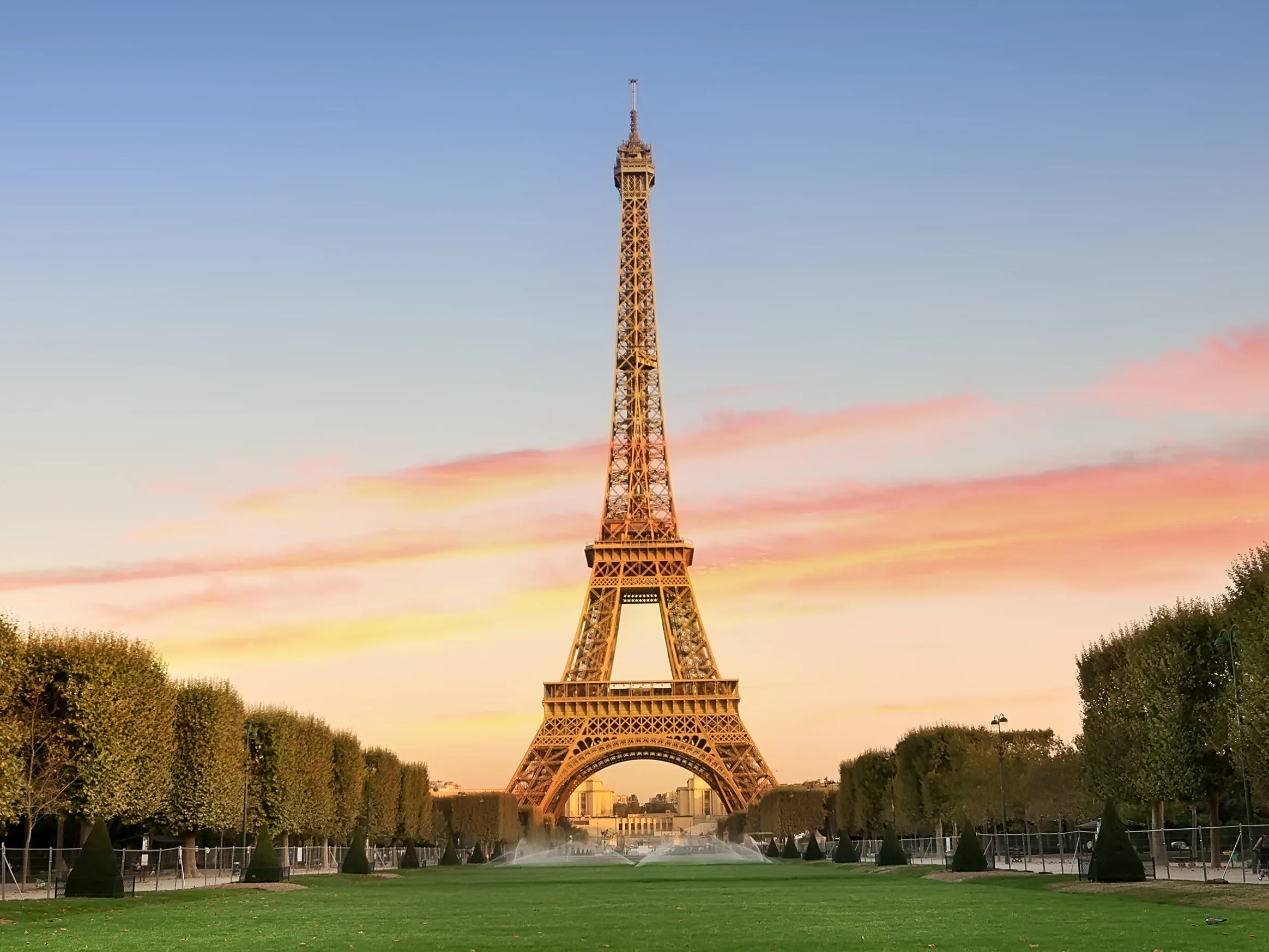
Paris
The magic of Paris is undeniable. This is the most romantic destination in Europe, and surely the number one bucket list destination of all time. If you want to say you've traveled, you have to visit Paris at least once. Along with classic must-sees like the Eiffel Tower and the Sacre-Coeur, there is so much to see and do in Paris that it helps to narrow it down by interest. Fashion and shopping enthusiast? Look no further than the Galeries Lafayette, Avenue des Champs-Élysées, or the Marais. Art aficionado? Once you're done with the Louvre, make a start on the Musée d'Orsay. History buffs won't be able to walk a block without uncovering a monument to Napoleon or Louis XIV. If you visit Paris with a foodie, be warned — you'll gaze in a lot of patisserie windows, and sample your weight in croissants. Because Paris always has so much on offer, it never grows old. At dusk, as you stroll the wide boulevards past Haussmann apartment buildings and sharply dressed Parisians, or gaze down at the city from the hill at Montmarte, you might find yourself saying 'Paris Je t' aime'. This is, after all, the City of Love.

Learn About Paris
Build Paris Trip

Brussels
It feels as though everything in Brussels is tinted with gold. From the gilded rooftops of the old houses on the Grand Palace to the foil-wrapped bonbons piled in chocolatier windows, Brussels seems to sparkle and wink at you around every corner. Aside from the lustrous architecture and Trappist ales, this shiny city is probably still best known for its iconic street food options: salty, golden fries, and fluffy, honey-colored waffles. While a major political center, home of the EU and NATO, don’t be fooled by Brussels stern ‘Eurocratic’ facade. Brussels revels in cheeky humor and mischief. So much so, Brussel’s beloved mascot, the ‘Manneken Pis’, is a statue of a small child urinating into a fountain. The city takes great pleasure in dressing this statue in festive-themed costumes. It’s no surprise that the artist Magritte, one of the great visual tricksters of the 20th century, called Brussels home. After a few days exploring the city, and taking in its sights and scenes, you’re sure to come away smiling.

Learn About Brussels
Build Brussels Trip
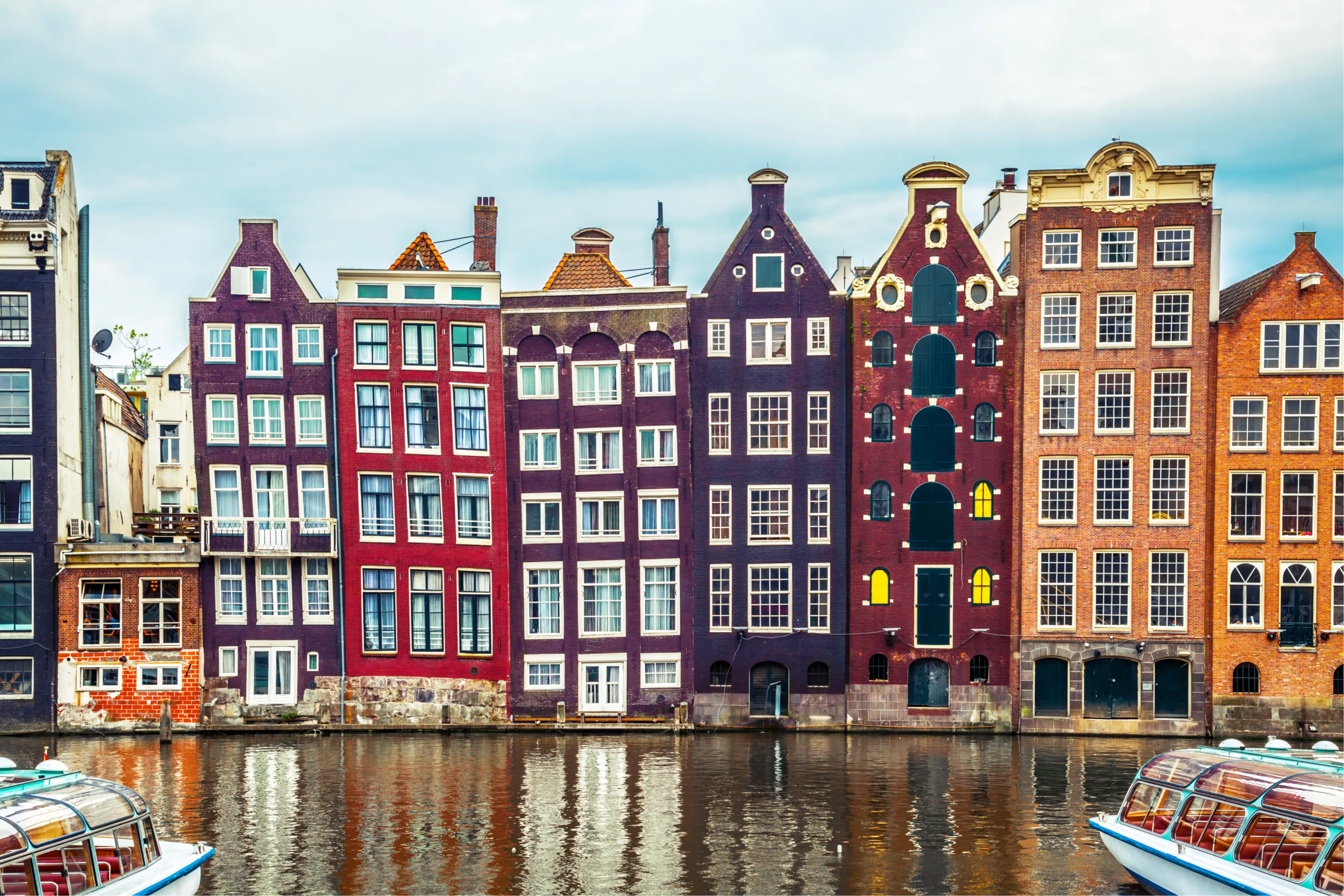
Amsterdam
A waterside metropolis with a low-key vibe, a visit to Amsterdam is as fun and freewheeling as a fixed-gear bicycle. This is the city where you can let it all go. The streets of Amsterdam chime with bicycle bells and the laughter of people making their way between bars. Yellow wheels of cheese line shop windows, and in springtime, market stalls are abundant with the famous Dutch tulips. Younger than other cities in the Netherlands, Amsterdam sprang to life in the 17th century, when it became flush with trade from the Dutch colonies. From the gable tipped houses standing shoulder-to-shoulder on the canals to the Rembrandt paintings hanging on the walls of the Rijksmuseum, Amsterdam is strewn with relics from the Dutch Golden Age. Whether you rent a bicycle, float down a canal, or just sip on an amber-colored lager and watch the world go by, Amsterdam makes a lasting impression from start to finish.

Learn About Amsterdam
Build Amsterdam Trip

Bayeux
Bayeux is an old, well-preserved town in Normandy. Most known as the backdrop for the Battle of Normandy, visitors who descend from WWII veterans often feel a special, somber connection to this part of France. On June 6, 1944, otherwise known as ‘D-Day’, thousands of Allied troops landed on Normandy’s Atlantic Coast, with a mission to drive out the German occupying forces. More than 120,000 Allied soldiers died in combat over the next three months. Although victorious, the campaign for Normandy caused the highest number of losses for America in all of WWII. A landscape of remembrance, on a tour of the Norman countryside you’ll see the remains of tanks, aircraft, and military bunkers. Special cemeteries and memorials in the area pay tribute to the sacrifice of fallen soldiers. Despite the destruction of nearly every neighboring village, the town of Bayeux endured WWII unscathed. Along with all its medieval architecture, the town’s most precious treasure, the Bayeux Tapestry, was miraculously spared. Stitched in the 11th century, the Tapestry tells the story of William the Conqueror’s invasion of England in 1066. As you view the tapestry and stroll through the charming streets of Bayeux, the sweeping cathedral spires and gently flowing River Aure cast you back to another time. A landscape of war, but also remembrance, a trip to Bayeux and Normandy will deepen your appreciation and respect for the past.

Learn About Bayeux
Build Bayeux Trip

Aix en Provence
Aix en Provence is a warm city baked into the Provence-Alpes-Côte region of Southern France. Often referred to as simply ‘Aix’, this city is a starting point for traveling the Provencal region. Aix is set amongst a backdrop of rambling vineyards, quaint villages, and the imposing Sainte-Victoire mountain range. It’s no surprise that artists like Cézanne have devoted lifetimes to painting this landscape. Aromatic lavender fields in the north blossom once a year with a scent that defines the French countryside. Head south and you’ll find the rocky Mediterranean shore with dramatic Calanques cliffs and clear blue waters. With the sun out nearly all year round, locals live the epitome of the Mediterranean lifestyle. Wander through narrow medieval streets, shop at lively marketplaces, and enjoy a glass of rosé on a cafe terrace beneath the gentle Provencal sun. From old-world architecture and bubbling fountains to refined galleries and leafy parks, this leisurely city has everything you could ask of a French vacation.

Learn About Aix en Provence
Build Aix en Provence Trip

Rennes
Rennes is the capital of Brittany, the most northwest region in France. A sea and countryside getaway, Brittany is famous for its medieval towns, ancient rocky landscapes, and seaside villages. Dotted along the blue-green Atlantic coastline, towns like St. Malo, Dinard, and Cancale are long-time summer vacation spots for the French. Needless to say, you have to try the fresh seafood. Offshore, the island of Mont-Saint-Michel rests dreamily amongst the waves. One of the most beloved UNESCO heritage sites in France, this medieval abbey is connected to the mainland by a bridge over a causeway. Heading inland, there are centuries-old churches, stone cottages, and castles that belonged to Brittany’s medieval royalty, who were known for constantly feuding over successions. The river town of Dinan is surrounded by a fortress wall, a must-see for both its history and profound beauty. In Rennes, half-timbered houses and cobbled streets give way to some of the oldest marketplaces in France. Rennes itself is a tranquil, medium-sized city, easily explored in half a day. In the evening, the city’s gastronomic scene invites you to try local specialties - pancakes, such as savory stuffed galettes and thin, lemony crêpes, are the order of the day here.

Learn About Rennes
Build Rennes Trip

Paris
The magic of Paris is undeniable. This is the most romantic destination in Europe, and surely the number one bucket list destination of all time. If you want to say you've traveled, you have to visit Paris at least once. Along with classic must-sees like the Eiffel Tower and the Sacre-Coeur, there is so much to see and do in Paris that it helps to narrow it down by interest. Fashion and shopping enthusiast? Look no further than the Galeries Lafayette, Avenue des Champs-Élysées, or the Marais. Art aficionado? Once you're done with the Louvre, make a start on the Musée d'Orsay. History buffs won't be able to walk a block without uncovering a monument to Napoleon or Louis XIV. If you visit Paris with a foodie, be warned — you'll gaze in a lot of patisserie windows, and sample your weight in croissants. Because Paris always has so much on offer, it never grows old. At dusk, as you stroll the wide boulevards past Haussmann apartment buildings and sharply dressed Parisians, or gaze down at the city from the hill at Montmarte, you might find yourself saying 'Paris Je t' aime'. This is, after all, the City of Love.

Learn About Paris
Build Paris Trip

Brussels
It feels as though everything in Brussels is tinted with gold. From the gilded rooftops of the old houses on the Grand Palace to the foil-wrapped bonbons piled in chocolatier windows, Brussels seems to sparkle and wink at you around every corner. Aside from the lustrous architecture and Trappist ales, this shiny city is probably still best known for its iconic street food options: salty, golden fries, and fluffy, honey-colored waffles. While a major political center, home of the EU and NATO, don’t be fooled by Brussels stern ‘Eurocratic’ facade. Brussels revels in cheeky humor and mischief. So much so, Brussel’s beloved mascot, the ‘Manneken Pis’, is a statue of a small child urinating into a fountain. The city takes great pleasure in dressing this statue in festive-themed costumes. It’s no surprise that the artist Magritte, one of the great visual tricksters of the 20th century, called Brussels home. After a few days exploring the city, and taking in its sights and scenes, you’re sure to come away smiling.

Learn About Brussels
Build Brussels Trip

Amsterdam
A waterside metropolis with a low-key vibe, a visit to Amsterdam is as fun and freewheeling as a fixed-gear bicycle. This is the city where you can let it all go. The streets of Amsterdam chime with bicycle bells and the laughter of people making their way between bars. Yellow wheels of cheese line shop windows, and in springtime, market stalls are abundant with the famous Dutch tulips. Younger than other cities in the Netherlands, Amsterdam sprang to life in the 17th century, when it became flush with trade from the Dutch colonies. From the gable tipped houses standing shoulder-to-shoulder on the canals to the Rembrandt paintings hanging on the walls of the Rijksmuseum, Amsterdam is strewn with relics from the Dutch Golden Age. Whether you rent a bicycle, float down a canal, or just sip on an amber-colored lager and watch the world go by, Amsterdam makes a lasting impression from start to finish.

Learn About Amsterdam
Build Amsterdam Trip
prev
next


 Map of Your Itinerary Route
Map of Your Itinerary Route
Zoom In to the cities to see your itinerary in more detail


 4.8
4.8 






